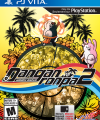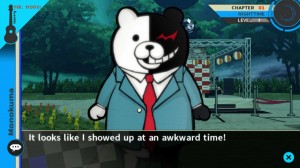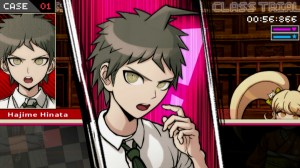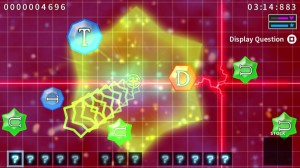The long-awaited sequel to the hit visual novel for Playstation Vita, Danganronpa, has now arrived. The original Danganronpa released earlier this year to much high-praise for its over-the-top storyline and class trial gameplay. All of that is kept well intact for Danganronpa 2: Goodbye Despair with a new story and cast of characters, as well as more things to do during the intense class trials. If you’ve enjoyed the first Danganronpa game, it’s a no-brainer to get the second one. However, for those on the edge or curious to see how the sequel holds up, read on.
Danganronpa 2: Goodbye Despair features a new cast of characters who find themselves in a similar situation that was experienced in the original Danganronpa. You have a group of 16 students who attend Hope’s Peak Academy as “Ultimates” in a specific talent. They were looking forward to attending the academy, when suddenly they find themselves on a archipelago called Jabberwock Island. After a series of events, they are put into a killing game where they’ll have to kill a fellow classmate if they wish to leave the island. A similar storyline to the first, but full of its own twists. So you’ll be sucked into the world of Danganronpa all over again.
The core gameplay of Danganronpa 2 is also like the first. You’ll play as the main character, Hajime Hinata, as you explore Jabberwock Island and interact with your classmates in order to progress the story. At some point a murder will occur which will trigger an investigation. Your job is to then gather evidence that will help lead everyone to the truth of who the killer is. The gameplay for these moments plays out like your typical visual novel and adventure game.
This all leads up to the Class Trials, where you’ll see the majority of gameplay. Within these portions, you’ll need to argue or agree with the statements made by your classmates in order to pinpoint the killer. Your evidence will become truth bullets which you will use to shoot down false statements or agree with facts. Various other mini-games will also take place in which you’ll have to utilize your knowledge of the crime scene in order to proceed. If you’ve played the first Danganronpa, you already know what to expect, but all mini-games from the first have been rebuilt for the sequel and new mini-games were also added.
The Good: The stand-out point for these Danganronpa games are the Class Trials. It’s where you’ll see the action in terms of gameplay. So it’s very important these portions be good. Fortunately, they are quite fun to play through. They are simple, yet challenging in their own ways. The explanations to these mini-games are kind of rough, but once you’ve tried out the mini-game yourself you’ll understand what it wants you to do.
Just like with the first Danganronpa, the presentation in Danganronpa 2 really shines. The same Anime visuals make a return, but it’s the voice overs that bring everything to life. The English dub is much better this time around compared to the first. With the original, I found a couple voices to be a little off and inconsistent at times. For the sequel, I’ve pretty much enjoyed the voices throughout the game. It’s not perfect, as you’ll come across a few moments or lines that could have been done a bit better. Overall though, I’d say the voice work really made this game for me. Of course, if you prefer the original Japanese audio, that is available as well.
Replayability is kind of encouraged with Danganronpa 2. Even though the tension is sort of gone once you play through the story and experienced all its twists and turns, there are some incentives to dive back in. Aside from Trophy-related reasons, you can replay Class Trials on various difficulties and earn coins, which you can use to earn more presents. And these presents can then be used to unlock secret story sequences or more backstory on the other students. Even an actual light novel is included in the game, that features an alternate telling of the first game’s events titled, Danganronpa IF.
Along with the main story, there are other side games, one of which is the returning School Mode or Island mode for DR2. The premise is the same, where it’s an alternate storyline and the students are no longer forced to kill each other and are instead working together to make various items. It’s essentially a time management game as you guide the students on where to gather items in order to make the required items. Stamina plays a key here, so there will be days they have to rest. Fulfill the item request within the required amount of days and you’ll earn tickets to deepen your bonds with others. It’s a simple mode that helps add more backstory to the colorful cast of characters and takes a decent amount of time to fully complete.
The Bad: One other side game though wasn’t particularly great to play through. That’s a sort of action game that revolves around one the game’s characters, Monomi. You defeat multiple waves of enemies in these small arenas by running and making circles around them. You’ll find presents from them which may contain better equipment to make Monomi stronger. The overall game was simple to understand and play, but it’s probably my least favorite thing to go through in the game. It’s tolerable, but the game is pretty much hit or miss with its repetitive and lackluster gameplay. Luckily, it’s not really required for anything, other than trophies, if you find yourself not really into it.
With lots of mini-games in the trials, you’re also bound to possibly have a couple you’re not looking forward to. I found myself feeling that way with the game’s new Hangman’s Gambit mini-game. It’s similar to the first Danganronpa, where you’re just trying to spell out a word by shooting letters floating on screen. This new iteration in Danganronpa 2 though furthers that concept by adding some puzzle elements to it. Instead of just shooting letters to spell out words, you’ll need to match up two letters before you can apply it to the word. Letters are constantly moving around the screen though, so some quick reaction time is required to complete these mini-games without taking damage. It’s actually simple to play, but I just found myself more frustrated with the difficulty. It felt like it would just suddenly feel impossible to not take damage, since you’ll see the screen suddenly fill up with letters with very little time to react before everything starts crashing. Equipping skills may make the experience easier, but I didn’t like those various difficulty spikes. A small nitpick really, but one that stood out to me.
The other minor, yet kind of unfortunate mishap I had with the game is with the localization. It’s well-written and nicely localized for the English-speaking audience. However, these are a few errors in the game. Typos were found and odd wording at times, though not too noticeable. But also, some weird formatting problems, where dialogue at specific points had more spaces than needed and were shown off-screen. These don’t necessarily ruin the game, but still an unfortunate thing to come across in text-heavy games like these.
Overall Thoughts: Danganronpa 2: Goodbye Despair is a great follow-up to the amazing Danganronpa. It features a more over-the-top story with plenty of likable characters who are brought to life by some wonderfully done voice work. The new mini-games were enjoyable to play through, and provided a nice challenge. Lots of play time to be had even once you’re done with the main story. Playing the first game is quite essential in really enjoying Danganronpa 2. These are a couple of the best games available for Playstation Vita so I highly recommending playing both of them.

















I really enjoyed he story of the first game however some of the gameplay elements could have been alot better. Hopefully I can trully say godbye despair when this game comes out